Jelsa Trail Race to Showcase UNESCO Heritages of Hvar Island
March 15th, 2022 - An exciting event has been announced by the Jelsa Tourist Board: the first trail running race to take place in this part of Hvar island
The recently announced Jelsa Trail is a bit different than your average trail race. Namely, it will retrace the route of the renowned procession Za križen (Behind the cross), which takes place every Maundy Thursday on Hvar island. The race is scheduled for Saturday, April 23rd, ten days after the traditional procession.
And what a setting for a trail race! Hvar island boasts no less than six UNESCO heritages, Za križen being one of them. You’ll get to discover a few more as the immensely scenic trail takes you through olive groves and vineyards, with cerulean waters of the Adriatic as a backdrop. The route runs through the Stari Grad Plain and along numerous dry stone walls, both UNESCO heritages.

Participants can compete in one of three categories, all endearingly named after a few local favourites:
Srdelica (Sardine) - 5 km, +260 m
The shortest and easiest route Srdelica is beginner-friendly and a perfect choice for those who’d prefer to participate in a more casual manner, soaking in the sights while they walk the trail at a comfortable pace. The trail starts and ends on the waterfront in Jelsa, in the meantime offering wonderful views of island scenery, including the splendid view from the ancient tower Tor. There won’t be an aid station on this trail, and the time limit to finish the race is 2 hours.
Škarpina (Scorpionfish) - 11 km, +420m
This route is beginner-friendly, but also suitable for more experienced runners. The trail starts and ends on the waterfront in Jelsa. After the initial ascent and passing by the tower Tor, the trail continues to run through olive groves and vineyards to the picturesque Pitve village, then back to Jelsa. The trail will have one aid station in Pitve (7km mark), with 3 hours allowed to finish the race.
Šanpjer (John Dory) - 20 km, +620m
The longest route requires a higher level of physical fitness, but isn’t technically challenging. Like the other two, the Šanpjer trail starts and ends on the waterfront in Jelsa. After they pass by the ancient tower Tor, runners will head to Pitve and then follow the route of the renowned procession Za križen. The trail runs through gorgeous places in the environs of Jelsa: Pitve, Vrisnik, Svirče, Vrbanj and Vrboska. Two aid stations will be set up on this route, in Pitve (7km mark) and Vrbanj (12km mark). Four hours are allowed to finish this route, with an added time limit halfway through - racers are allowed 2 hrs 15 mins to reach the checkpoint in Vrbanj.
Sweet and salty snacks will be offered at the aid stations, together with fruit, water and juice. After the race, you can look forward to a proper Dalmatian feast in Jelsa, complete with klapa singing.
The winners will be awarded medals in the shape of Hvar lace, another iconic Hvar feature to bear a UNESCO title.
Interested? You can register for the race on Stotinka.hr - everyone who pays the entry fee before April 14th gets a t-shirt and a glass water bottle for free, both adorned with the Jelsa Trail logo.
New Hotel in Komiža Will Put Too Much Pressure on Public Infrastructure, Claim Local Residents
March 14th, 2022 - Komiža residents are worried whether the public infrastructure of their town, which covers an area of 48 square kilometres and has a population of 1,500, will be able to withstand the increase in road traffic expected after the new hotel opens for business
Residents of Komiža, a coastal town on Vis island, have been voicing their concerns lately in regards to the announced construction of a new hotel, reportedly twice as big as what the public infrastructure in this little town could withstand.
The first public presentation of the new Hotel Biševo was scheduled for today, but only city councillors and members of the Department of Urbanism and Physical Planning were invited to attend. The residents of Komiža, in turn, haven’t been invited, and they’re rightfully worried that the new hotel with 700 beds is going to put too much pressure on their little town, reports Morski.hr.
The old Hotel Biševo was a two-star facility with 300 beds. A new luxury hotel with double the capacity will be built in its place, further increasing the number of guests in the already popular destination.
The investor was the one who decided that the residents shouldn’t attend the presentation, as stated in the invitation. The hotel is owned by PBZ Croatia Osiguranje, a compulsory pension fund. It’s also known that the project involves the company Modra Špilja d.d. from Komiža, architecture studio 3LHD from Zagreb and the company Urbos d.o.o from Split, with the latter known to deal in physical planning.
Komiža residents have reason to wonder whether the public infrastructure of their town, which covers an area of 48 square kilometres and has a permanent population of 1,500, will be able to withstand the increase in road traffic expected after the hotel is put into operation. The citizens are not against the hotel, but they’re calling for a facility of appropriate size and capacity for a place like Komiža.
Concerned councillors and citizens have addressed the competent ministries on several occasions, most often in regards to the legality of the process and the decision not to involve the citizens in the process of modification of zoning plans, but have not yet received proper answers.
‘The public will be involved once a public consultation is announced’, stated Komiža Mayor Tonka Ivčević in a short reply to the latest inquiry from Morski. Although it’s been nearly a month since they’ve sent her a detailed query regarding the project, the mayor has only replied with the above statement this morning, after they pointed out that ignoring reporters won’t help her turn the public’s attention away from the matter.
Mayor Ivčević has reiterated that ‘the interest of Komiža locals is her top priority’ and that ‘she would never allow for anyone to disrupt the development of Komiža for the benefit of its residents in any way’.
Many guests and returnees are worried for the future of Komiža, as they’ve chosen to live or stay in this town exactly because it’s quiet, peaceful and pleasant to reside in. The question is, how long is it going to remain that way?
Via Apsyrtides, Long Distance Hiking Trail That Redefines Island Hopping
March 10th, 2022 - The trail is 149 km long in total and connects the islands of Cres, Lošinj and Ilovik
A unique hiking trail has been established in Croatia that will redefine island hopping. Named Via Apsyrtides, the transversal runs through the islands of Cres, Lošinj and Ilovik, providing a new way to explore the Croatian coast and bask in the dreamy Mediterranean vibes unbothered by the summer crowds.
The long distance trail connects Cape Jablanac, the northernmost point of Cres, with Cape Radovan on Ilovik island at the southern tip of the archipelago. The trail is approximately 149 km long in total and consists of 11 stages varying in length and difficulty, totaling 4,000 metres of elevation.
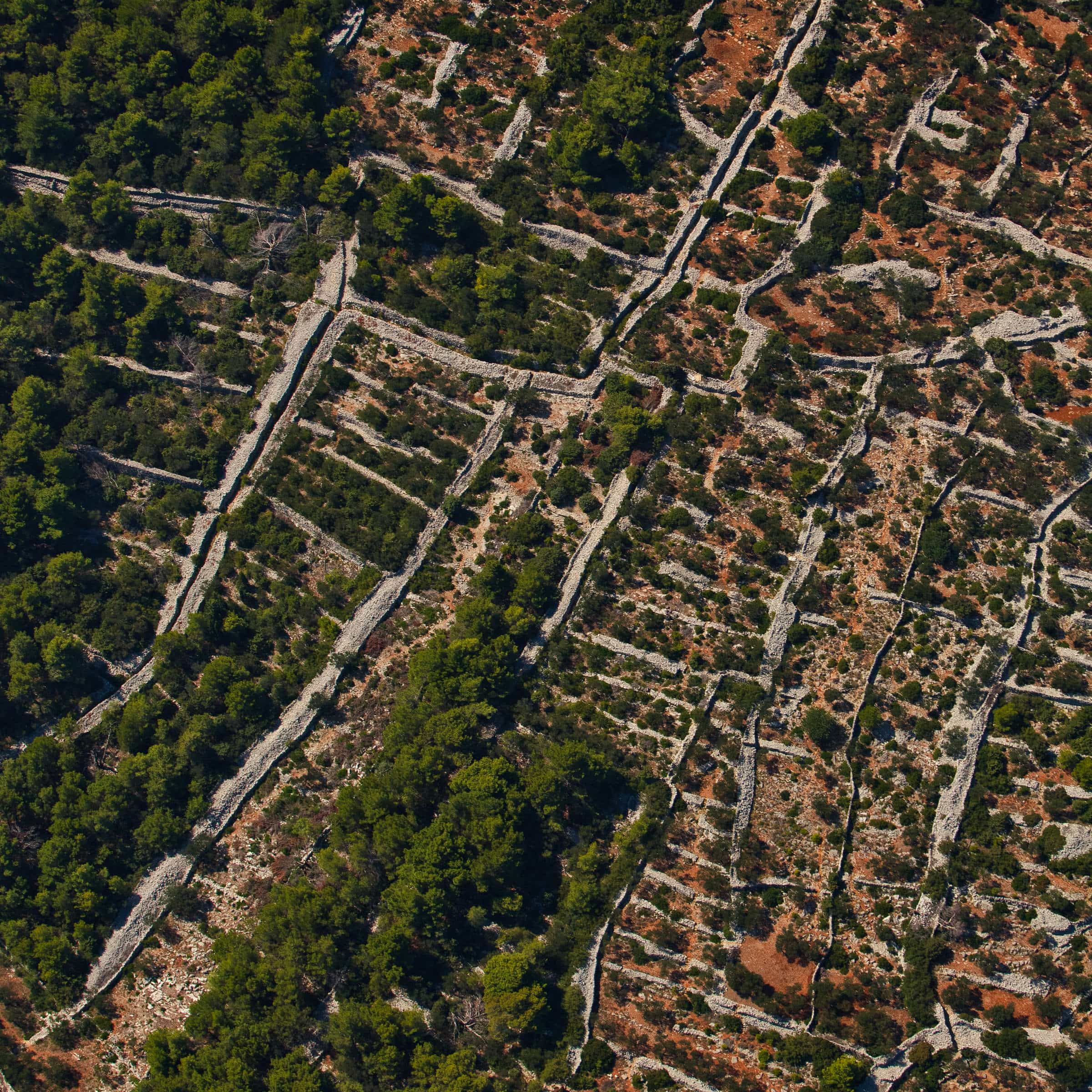 Lošinj / Mario Romulić
Lošinj / Mario Romulić
Why Via Apsyrtides? The poetic name has its origins in the Greek myth of Jason and the Argonauts, a story which also gave the name to the entire archipelago of Cres and Lošinj.
When the Argonauts fled Colchis with the Golden Fleece, Medea’s brother Apsyrt was tasked with retrieving the stolen treasure. Legend has it that Apsyrt finally caught up with the crew in the Northern Adriatic, whereupon he was tricked by his own sister and was captured by Jason’s crew.
Jason killed poor Apsyrt and Medea then chopped his body into pieces, which transformed into islands upon being thrown into the sea. An unnecessarily cruel move, perhaps, but the newly formed archipelago was named the Apsyrtides in his honour.
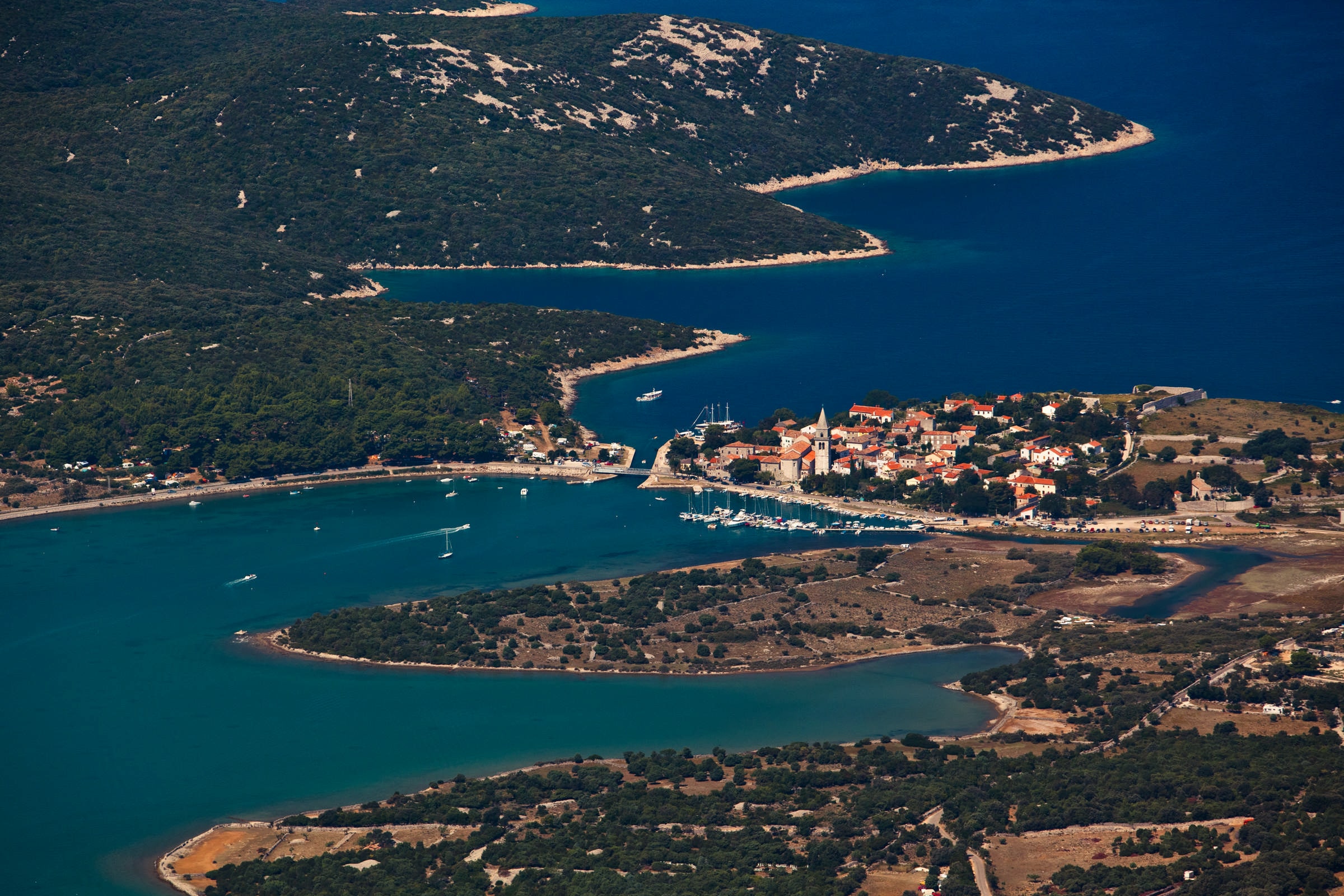 Osor town, Cres island / Mario Romulić
Osor town, Cres island / Mario Romulić
Via Apsyrtides now runs through the entire archipelago and is almost ready to welcome the first thru hikers. Along the way, they’ll learn about the cultural heritage of the islands and their wondrous natural features. It’s envisaged for the trail to become a tourist product, one that will attract visitors outside the summer season and thus contribute to the development of sustainable tourism in the area.
hatIn 2021, a historic network of 75 kilometres of trails on Cres were restored as part of the European project VALUE. They’re now connected to the Via Apsyrtides transversal and marked with the recognisable VA logo in blue and red, along with educational panels put up along the route to get the hikers better acquainted with the island.
Trail marking was carried out by the company Xplore Cress in cooperation with authorised markers and according to the standards of the Croatian Mountaineering Association.
A comprehensive website is in the works that will present a detailed overview of all the stages, complete with trail maps and selected sights to discover along the route. The site is still under construction and should be completed in a few weeks, but the map and the overview are ready to explore - head here to discover what wonders await at Via Apsyrtides.
Floating Bin Installed in Cres Port to Filter Sea Water and Collect Waste
February 14th, 2022 - The device collects an average of 1.5 kg of floating debris per day
A new device was recently installed in Cres port to help prevent sea pollution. Called ‘Morska škovacera’ in Croatian, the sea bin is meant to collect floating debris in the main port on Cres island.
The floating bin continuously filters seawater by collecting plastic, microplastic, detergents, oils and other substances from the surface, preventing them from floating out to sea or falling to the seabed where they can harm marine life.
The device collects an average of 1.5 kg of floating debris per day, reports Morski.hr.
A panel was installed on the pier containing more information regarding the new device and the praiseworthy project in general.
‘The floating waste arrives in the sea through the negligent behaviour of individuals, but also as a consequence of activities in various economic fields and represents a significant global environmental problem with a wide range of impact on marine life. Among the waste that reaches the sea, plastic is a special problem because it gradually decomposes into so-called microplastics which, absorbing various toxic substances and harmful microorganisms, enter into the food chain and eventually come to the table of fish consumers, endangering their health.
The goal of the project Morska škovacera is to raise awareness of the general public about the issue of floating waste and plastic in the sea, and is part of a broader effort of the Town of Cres and the island community to reduce the use of plastic and production of marine waste’, the panel reads.
The project was implemented by the local utility company Komunalne usluge Cres Lošinj d.o.o in cooperation with the County Port Authority of Cres. It’s worth around HRK38,000 and was financed by the European Maritime and Fisheries Fund.
‘Superstitious and Debauched’: Impressions of Croatia in Travel Journals of Yore (III)
February 8th, 2022 - In the third and final part of our series, our travellers explore the Kvarner area, discovering bura wind, scampi, and wellness
In our last feature on travel journals documenting trips to the Adriatic, we left off in southern Dalmatia. And now, where our travellers would depart for Montenegro, we’ll circle back to the Northern Adriatic instead. This time, we’re tagging along with A. Fortis (1770s) and G. Marcotti (1890s) - see Part I and Part II for more info and some impressions of Istria and Dalmatia.
Why go back? A good few places were left out of both previous pieces for the sake of brevity, so we’re making this a trilogy to see what our protagonists thought about the Kvarner gulf. It’s a detour alright, but in the words of Fortis who expressed a similar sentiment in one of his letters:
It is a massive geographical leap to move from the island of Brač straight to the island of Rab which is one hundred and twenty miles away. But what can I tell you?
Exactly. But before we get to Rab and other Kvarner islands, let's make a stop in Senj. It’s a coastal town best known for the magnificent Nehaj fortress, a historic stronghold of Uskoks who kept invaders at bay. Fortis says:
A very famous city in the history of the Venetian Republic which had to formally wage a war against it and, being unable to conquer it for a long time, suffered heavy losses in its possessions in Istria and Dalmatia; it was a subject of interest for a Venetian traveller. I wanted to meet the descendants of those fierce Uskoks who were admired for their courage and hated for their cruelty.
I wish I could learn their history as penned by one of them, but Uskoks fought heroically and dealt in ransom and loot collection, and did not write historical accounts.
You don’t say.
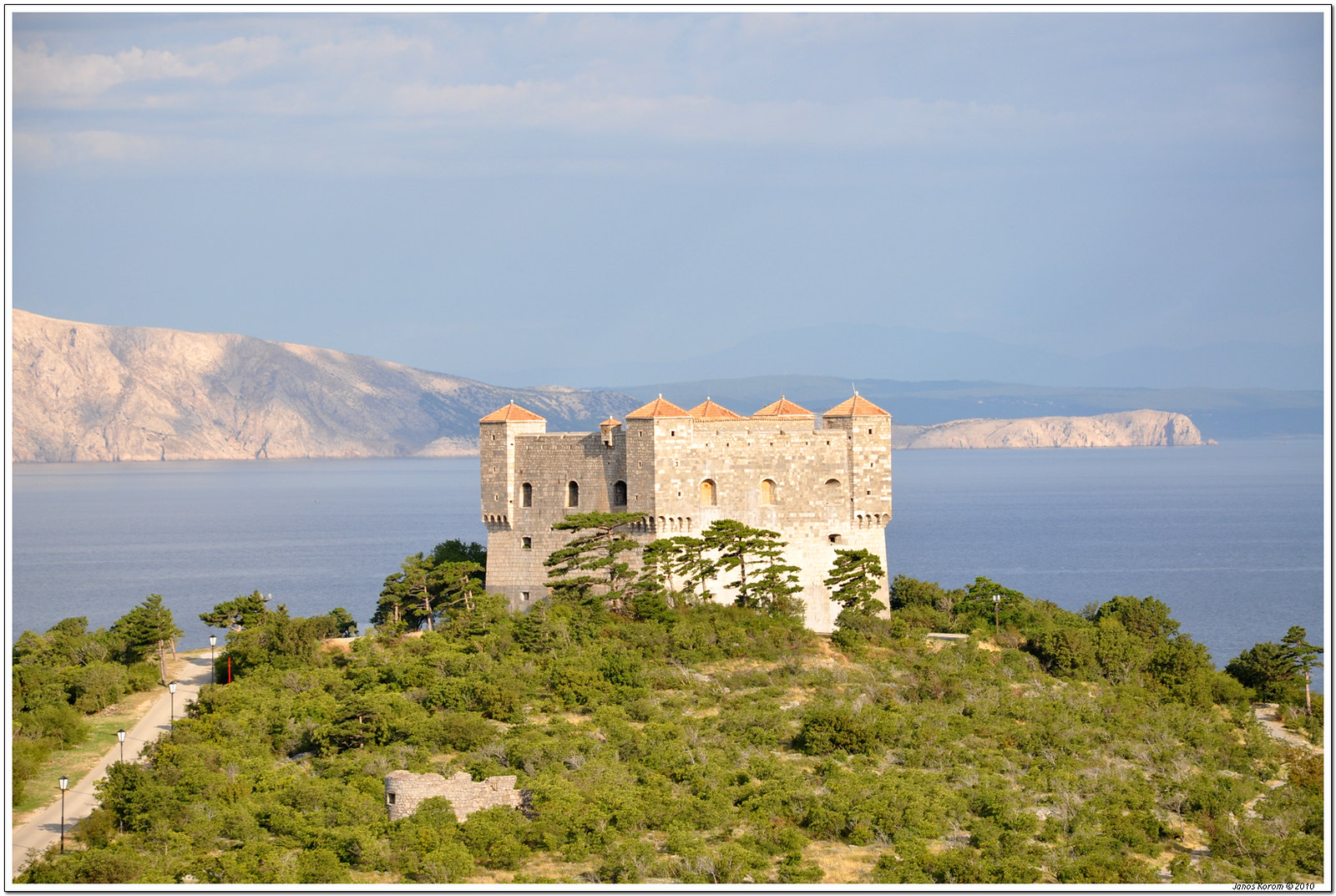 Nehaj fortress / János Korom / Flickr
Nehaj fortress / János Korom / Flickr
With Senj ruled by Austria at the time, the Uskoks truly were a source of headache for Venice; they defended the city, but also plundered Venetian galleys along with most other commercial ships in the area. Their conquests had a blessing of the local clergy, monasteries received a tithe from the bounty, and so the 16th-century Senj essentially thrived on piracy and looting. It's not a surprise then that its population might've seemed a bit, uh, laid-back to an outsider:
The people of Senj are superstitious and debauched at the same time. The women of this city are said to be prone to love affairs; they are easy-going and in this regard do not bear a resemblance to Croatian women.
Uh-oh. Shall we proceed with caution? Luckily, instead of lamenting loose morals, Fortis turns this into social commentary:
And so romantic adventures are frequent, and sometimes followed by unpleasant consequences. The bishop and the monastery heads who make up the court that deals with these matters issued a decree a few years ago, stipulating that if an unmarried woman were to give birth to a child, she could not sue her lover in court for marriage or possessions. This cruel ordinance led to an even greater decline of morals, and every year, many unfortunate girls are sacrificed to disgrace for which there is no cure; it is heartless and outrageous barbarism.
A progressive stance for the 1770s.
To finish, a few of his thoughts on the infamous Senj bura:
The wind coming from the barren mountains blows so fiercely in that narrow gap, there are times in winter when one cannot leave the house without peril, and it is even worse outside the city. Even when they do not walk across the square where no sensible person would appear at such times, but through the narrow winding alleys, it often happens that children and frail folk are lifted from the ground and slammed against the wall by the wind. When an urgent need compels someone to go to the docks where ships are anchored, despite crawling on their hands and knees they sometimes roll away like a straw because of the force of the wind.
Senj bura hasn’t lost any of its force to this day, and Fortis was wise not to take it lightly.
***
Now, to Rab. Those who read the first part of this series might recall his unabashed trashing of the poor populace of Pag island, and it would appear that Fortis really held a grudge against island folk in general:
The island of Rab would have everything needed to support its small population, if only its agriculture was in the hands of less stupid and lazy people.
He continues:
Nevertheless, [the island] produces firewood, shipped off to Venice on the backs of numerous donkeys each year, as well as grain, oil, excellent wine, brandy, and since the ancient times - silk, the silkworms feeding on black mulberry leaves. Exported are also leather, wool, sheep, pigs and horses of good breed.
I don’t know, they don’t sound that lazy to me. There’s more:
The sea is beginning to be of use, with salt pans maintained on the island that give an abundance of good fine salt. In addition, in spite of fishing being carried out here in a very poor and sloppy manner, the catch of tuna, mackerel and sardines is an important item in the trade of the people of Rab who (as the rest of Dalmatia) prefer to sell their goods to foreigners rather than Venetians. Despite all these natural products, the island is far from being rich or achieving adequate progress, as uncultivated land and idle peasants are too commonly seen.
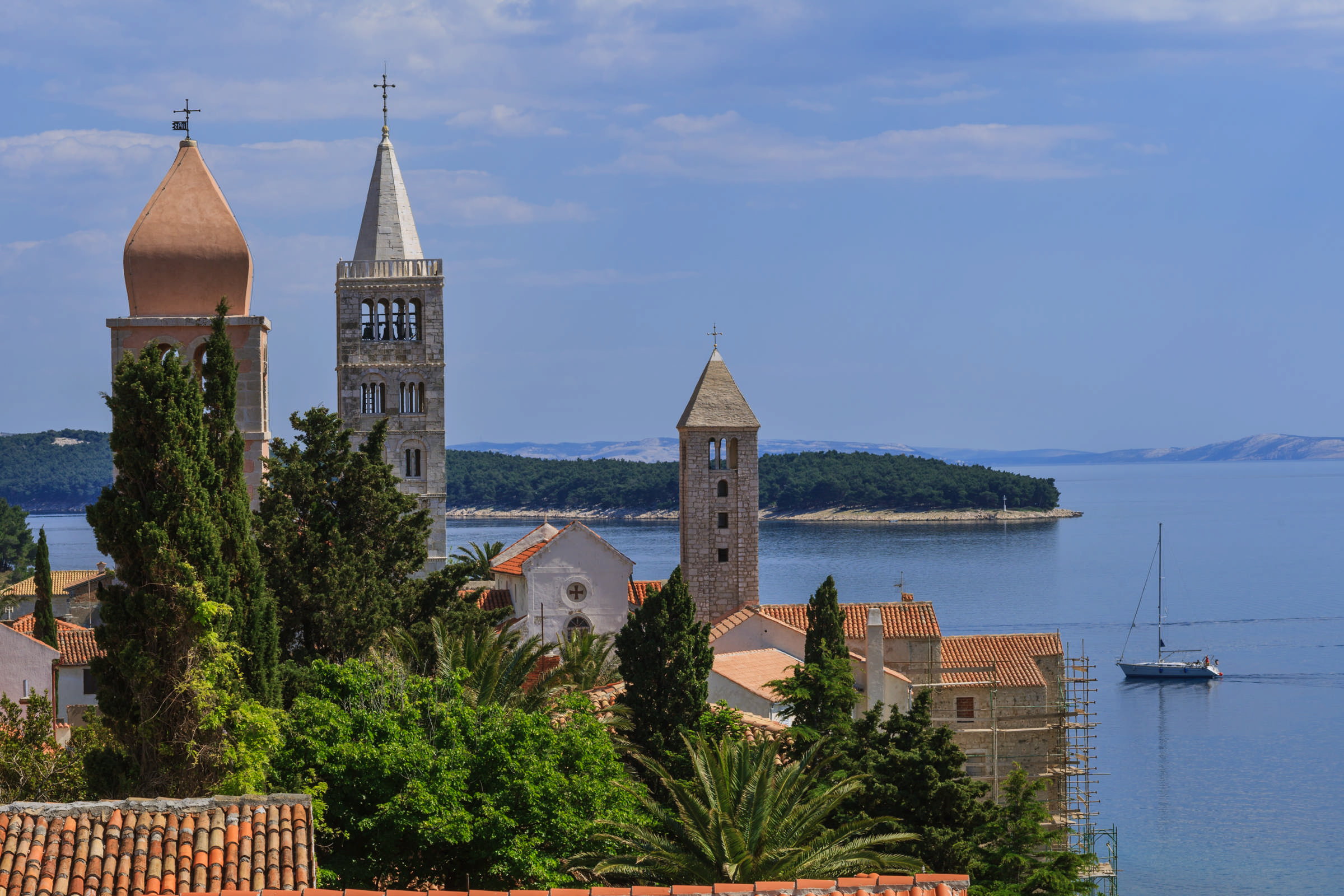 Rab town by Romulic and Stojcic
Rab town by Romulic and Stojcic
And an anecdote:
In the past, there was a bishop of Rab named Ottavio Spaderi; it occurred to him not to allow on the feast of St. Christopher for his relics to be displayed for public veneration, seeing as he doubted their authenticity. The folk rebelled, wanting to throw him into the sea from the top of the hill on which the cathedral stands, and the riots did not subside even after the moment had passed. The government had to send a warship to save the prelate from peril, and the pope considered it his duty to grant him a more submissive congregation in Italy.
Feisty. Fortis is lucky he wasn’t thrown from a cliff as well.
***
Later on, Marcotti writes about what you can find on Lošinj island:
A hunters’ association, a branch of the tourist club, a company for afforestation and landscaping. (...) There is no shortage of foreigners: Mali Lošinj has the Vindobona hotel, three special trattorias, five boarding houses. There are two other guesthouses and a resort for convalescent children in Veli Lošinj.
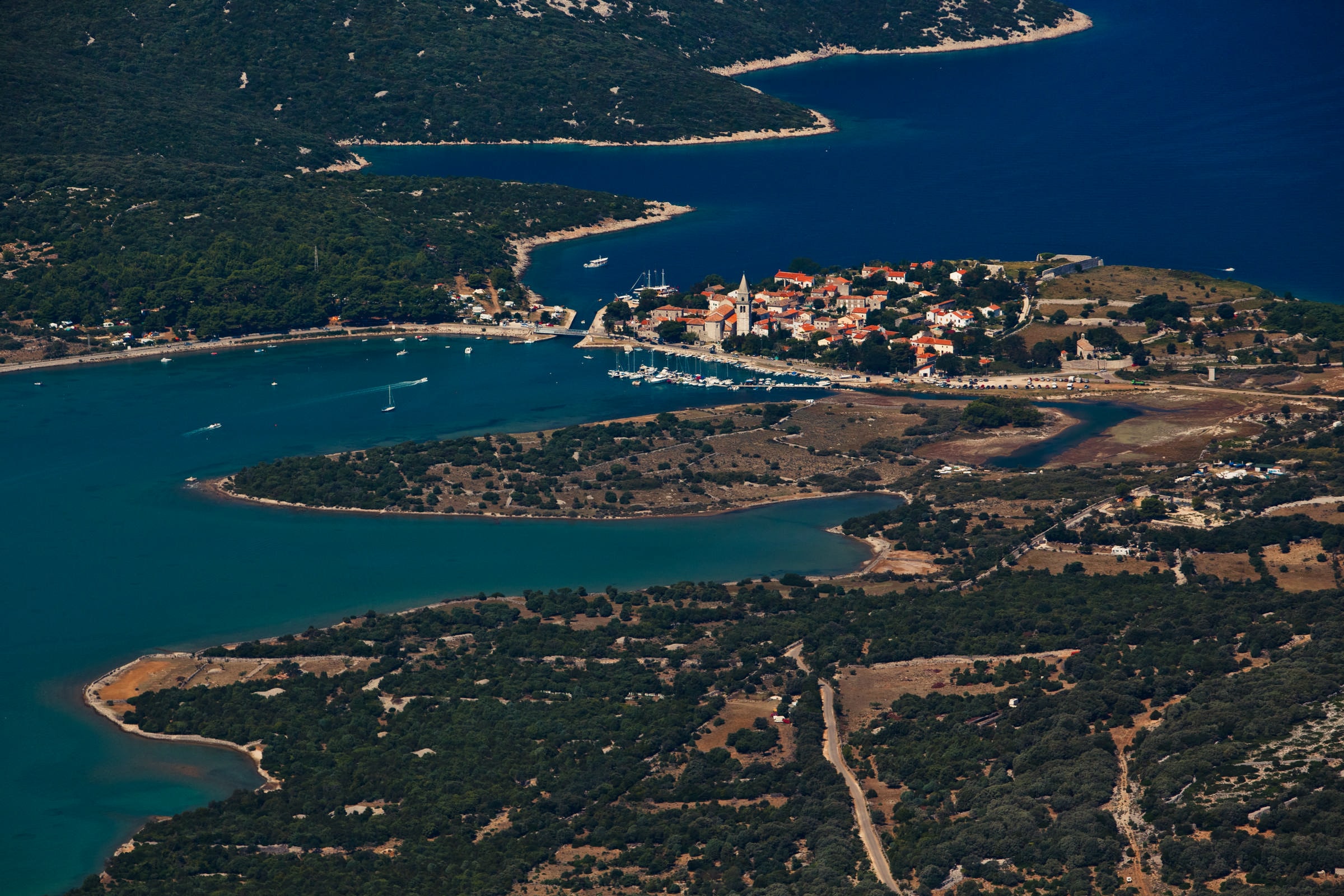 Osor town on Cres island by Romulic and Stojcic
Osor town on Cres island by Romulic and Stojcic
Visiting Cres island, he notes:
Generally speaking, sheep herding is difficult on islands of Kvarner due to bura; large juniper trees, grown and naturally shaped into canopies by the frequent pressure of the wind, provide shelter to roaming flocks.
***
On to Rijeka, the biggest town in the Kvarner gulf, visited by both our travellers. Fortis first:
Croatian is the native language. Refined folk of both sexes speak good Italian, imitating the Tuscan manner of speaking; surely they should be praised much more than us who butcher our beautiful language but mock everyone else who endeavours to speak it unless they are born in Tuscany.
The people of Rijeka are mild-mannered, and their company jovial, though marked by moderation.
Marcotti also spends some time in Rijeka and doesn’t let us down. Two of the most important things in any destination: where to eat and how to get around!
Numerous trattorias as well as those operating as part of hotels; breweries of the leading Austrian factories. Scampi are delicious, especially served in risotto. [There are] car services, omnibuses, public valets.
…that last one being a somewhat loose translation, referring to a particular profession: a person stationed in a public place ready to help you with any given need or errand. Think a concierge, a tourist guide, a messenger, a personal shopper, a delivery service, all rolled into one. Looking for directions to a certain place or perhaps need a hand with those shopping bags? The public valet’s got your back.
 Rijeka by Romulic and Stojcic
Rijeka by Romulic and Stojcic
He goes on:
The look of the city is really nice, its architecture Italian in character, though it offers little of note when it comes to art.
Ah well, you win some, you lose some. At least there are good scampi.
And for a final thought, a line used time and time again, a variation of which is probably currently displayed somewhere on the pages of the local tourist board:
The panoramic view of Rijeka and the Kvarner gulf as seen from Trsat is truly magnificent.
***
Opatija has grown into a fully fledged tourist destination by this point (late 1890s), and a health resort at that. Marcotti reports:
There’s a good number of nonagenarians in perfect health living on this riviera.
Its most sheltered and most pleasant place, Opatija, is advertised by the Südbahn company (Southern Austrian railways) as a health resort for the winter and sea-bathing in the summer. It has developed formidably and can barely accommodate the large clientele that flocks to it, particularly those from Austria-Hungary and Germany.
The entire facility cost the Südbahn no less than 3 million florins. There are milk, honey and egg treatments, massage, gymnastics, and walks for health.
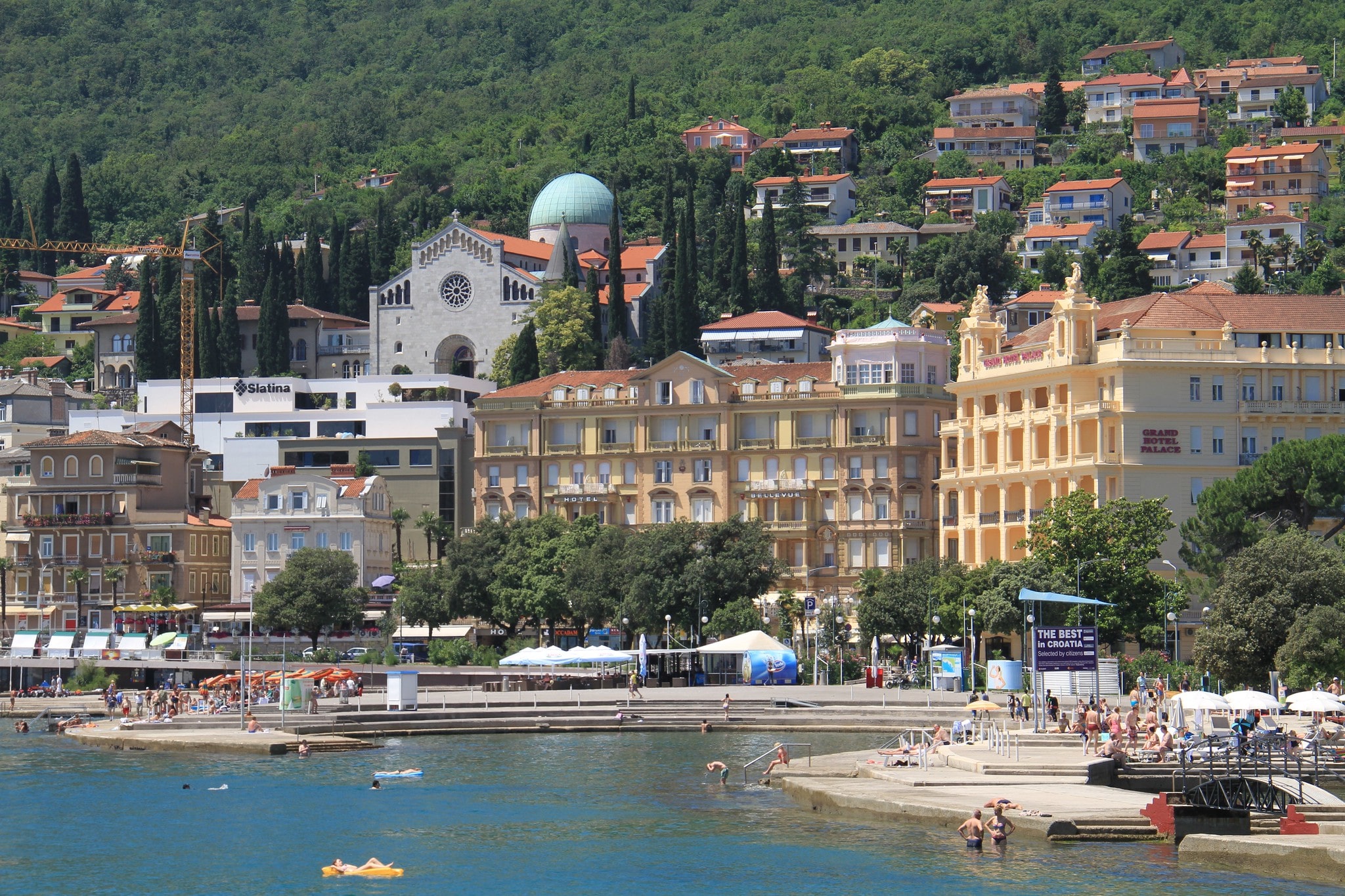 Opatija by Ronnie Macdonald / Flickr
Opatija by Ronnie Macdonald / Flickr
Some interesting insight into the early days of wellness, followed by a short recap showing just how quickly Opatija gained a reputation as a place to be:
Starting from 1885 (when Archduke Rudolf and his wife Stéfanie stayed here for the first time) visiting and staying in Opatija has become a pastime of high regard, very fashionable in court circles and among aristocrats and diplomats. This is from the 15th of October to the 15th of May: in the other five months, the bourgeois society visits for sea bathing. Empress of Austria, many archdukes and archduchesses, the royals of Serbia and Romania were some of Opatija’s guests.
***
With tourism becoming an industry, this seems like a good place to end this feature. Admittedly, when it comes to travel journals that paint a picture of the Croatian coast in earlier times, we’ve barely scratched the surface in our three-part series. Countless travellers have chronicled their Adriatic adventures, and providing you have time and the resolve to peruse old texts, it’s a fascinating body of work to study. We kept the scope small not to turn this into a dissertation, but hope you’ve enjoyed our travellers’ reviews anyway. Just keep in mind these are opinions of individuals from centuries past, and not neccessarily an actual representation of what Croatia is like - lazy folk, loose morals and local superstitions included.
Sources for Part III:
Giuseppe Marcotti, L’Adriatico Orientale, da Venezia a Corfu (1899)
Alberto Fortis, Viaggio a Dalmazia, 1774 (Croatian edition: Put po Dalmaciji, Globus, Zagreb, 1984)
Croatian Islands Need Recycling Yards and Waste Sorting Facilities
ZAGREB, 6 Feb 2022 - The Island Movement NGO has called on the residents of Croatian Adriatic islands to dispose of and sort their waste properly so it can be transported to the mainland for recycling, while local and state authorities have been urged to create infrastructure to promote a circular economy.
"Waste disposal is a major challenge for the islands, especially during the tourist season," warned Paula Bolfan, the movement's coordinator who organised the first in a series of "island dialogues" last week.
Speaking in an online discussion on the circular economy on the islands, Bolfan cited the example of Silba island off the city of Zadar where plastic wage management is a challenge. "Retail shops that are not larger than the size prescribed by law do not have to accept empty plastic bottles, and Silba only has two such shops, leaving the island full of plastic bottles during the summer."
Antonio Viskić from the Cres Lošinj utility company, which covers the two northern Adriatic islands, stressed the importance of building a regional waste management centre, saying "we don't have a single active waste dump on Cres and Lošinj any longer, as all the waste goes to the Istrian regional centre."
"We have set up separate containers for paper, glass and plastic waste, and have built stations for the transport of mixed municipal waste from the islands and recycling yards. Also, investment has begun in a waste sorting facility at Mali Lošinj," Viskić said of the steps the two islands were taking to achieve the circular economy.
Katarina Gregov, director of the Tourism Board of the island of Zlarin, off Šibenik, spoke of the "For a Plastic-Free Zlarin" initiative. "In order to reduce our plastic footprint, we have developed an idea to replace all single-use plastic products with multi-use and alternative materials," she said.
The initiative was launched four years ago and is supported by the entire island community, including cafe, restaurant and shop owners, who stopped using disposable plastic products. This volunteer project was praised by former president Kolinda Grabar-Kitarović at an annual UN General Assembly meeting.
Irena Hrković from the Environmental Protection and Energy Efficiency Fund commended the cooperation with Cres and Lošinj, announcing that this year local government units would be able to apply for tenders for vehicles using alternative fuels and for funding to increase their recycling capacity and clean up their landfills.
Hrković said that illegal landfills were a major problem, adding that nearly HRK 28 million (€3.7m) had been spent on landfill remediation.
Professor Davor Škrlec from the Zagreb Faculty of Electrical Engineering and Computing, who had dealt with the issue of the circular economy as a former member of the European Parliament, said that "the problem with waste disposal on the islands is seasonality."
"It is necessary to build sorting facilities on the islands so that waste can be properly separated and then transported to a waste processing facility on the mainland," Škrlec said.
For more, check out our lifestyle section.
Kornati National Park Finalist for 2021 Best European Filming Location
Kornati islands are among the finalists competing for the best European filming location of the year!
The European Film Commission Network (EUFCN) announced the five finalists competing for the Location Award 2021. In the fifth instalment of the annual competition, Kornati National Park made the cut as one of the filming locations for the award-winning Croatian film Murina.
Each year, all EUFCN member film commissions have a chance to nominate one location from a film or a TV series filmed in their country; the list of submissions is then reviewed by the Location Award Jury who select the top five locations to compete for the title. EUFCN state that the jury looks for locations that have a significant role in the story and innovative use in the audiovisual product.
Here’s a full list of this year’s finalists:
Berlin, Germany: The Queen’s Gambit
Cahir Castle, Ireland: The Green Knight
Malaga, Spain: The Crown (Season 4)
Stadlandet, Norway: Dune
Kornati National Park, Croatia: Murina
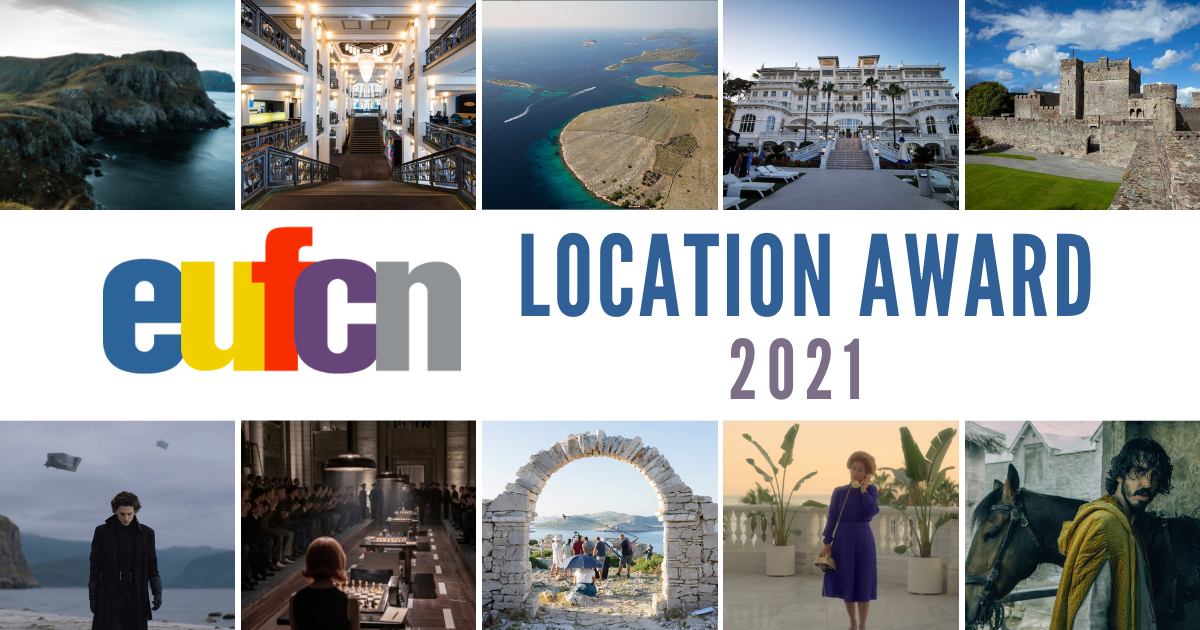 EUFCN - European Film Commissions Network
EUFCN - European Film Commissions Network
Voting is open to the general public - you can cast your vote until January 31st, 2022 at the EUFCN Location Award page. If you need an incentive, let it be known that one lucky voter will be randomly selected and awarded a trip to the winning location!
Murina was directed by Antoneta Alamat Kusijanović and stars Gracija Filipović, Leon Lučev, Danica Ćurčić and Cliff Curtis.
The Dubrovnik-born director’s first feature film won quite a few international accolades this year, most notably the prestigious Camera d’or award at the Cannes Film Festival in July. Murina had its Croatian debut at the Pula Film Festival where it won three awards: the Golden Arena for Best Supporting Actress (Danica Ćurčić), the Breza Award for Best Debutant (Antoneta Alamat Kusijanović), and the Golden Gate of Pula Audience Award for best film in the Croatian programme.
Apart from Kornati, the filming of Murina also took place on Hvar and Koločep island.
For everything you need to know about filming in Croatia, follow TCN's dedicated page.
7 Reasons Why You Should Visit Iž Island
June 6, 2021 - Croatia is known as the "land of a thousand islands" and yet, only a handful are popular and visited by tourists. There are so many more islands to discover in Croatia, and one of them is the quaint but highly underrated Iž Island with only 500 inhabitants.
I found out about the island of Iž because my very first friend in Croatia who is now one of my best friends was born and raised there. I met her for the first time when we both attended a violin masterclass workshop in Kaštela and she asked me and my Croatian husband if we could drop her off at where she was temporarily staying in Split. On the car ride home, my husband asked her where her hometown is and she answered, "Iž". Judging by my husband's reaction, she easily sensed that he has never heard of this place before and so she explained further, "it is a small island near Zadar and it is not very known because there are only around 500 people who live there and there is fewer every year." From then on, I have always been fond of visiting the small islands in Croatia and learning about the islanders' unique way of life. Coming from the city of Manila (Philippines), which has a highly dense population of 24 million people, it was unimaginable for me to live on a small island where only a few hundred people reside; but after spending two blissful summers on Iž, it turned out that life on a quaint and unspoiled island is astonishingly delightful!
#1 - Enjoy summer without the hustle and bustle of tourists
Located within both the Zadar and Kornati archipelago, Iž is nestled between the islands of Ugljan and Dugi Otok and can be reached daily by catamaran and ferry from Zadar. Iž is surrounded by many islets and private beaches so it is an ideal destination for relaxing and tranquil getaways. The island is divided into two villages - Mali Iž and Veli Iž. In Veli Iž, you can find two shops, a couple of bars and taverns that open in summer, a small marina, and the church of St. Peter and Paul from the 14th century. Even in summer, the island doesn't get too crowded because most of the tourists go to nearby islands like Ugljan and Preko because they are closer to Zadar and are more accessible. Because of this, you can easily find a private corner by the sea on Iž and enjoy a quiet time for yourself. The island is also great for hiking because of the asphalt paths and roads that connect the whole island. To enjoy the views of this island, you can hike to the top of Korinjak which is the highest peak on Iž with a height of 168 meters. From that viewpoint, you can see the nearby islands such as Dugi Otok and Rava.
#2 - Vegetarian and vegan-friendly
In Veli Iž, you can find the Korinjak Hotel and Camp which is the only purely vegetarian hotel in the Dalmatian region. It offers Meditteranean-inspired vegetarian cuisine to its guest including raw food dishes, fruit and vegetable smoothies, gluten-free, lactose-free, and vegan meals. It is a popular destination for long-time vegetarians and to those who are looking to change their diet and detox their bodies through various holistic retreats and workshops that are conducted in this hotel every summer including meditation, relaxation therapies for mind-body energy, yoga classes, pyramid meditation and sound, and organ therapies. The hotel also offers excursions and boat trips to hidden bays and secluded nearby islets where visitors can enjoy their own private beach and islet for the day.
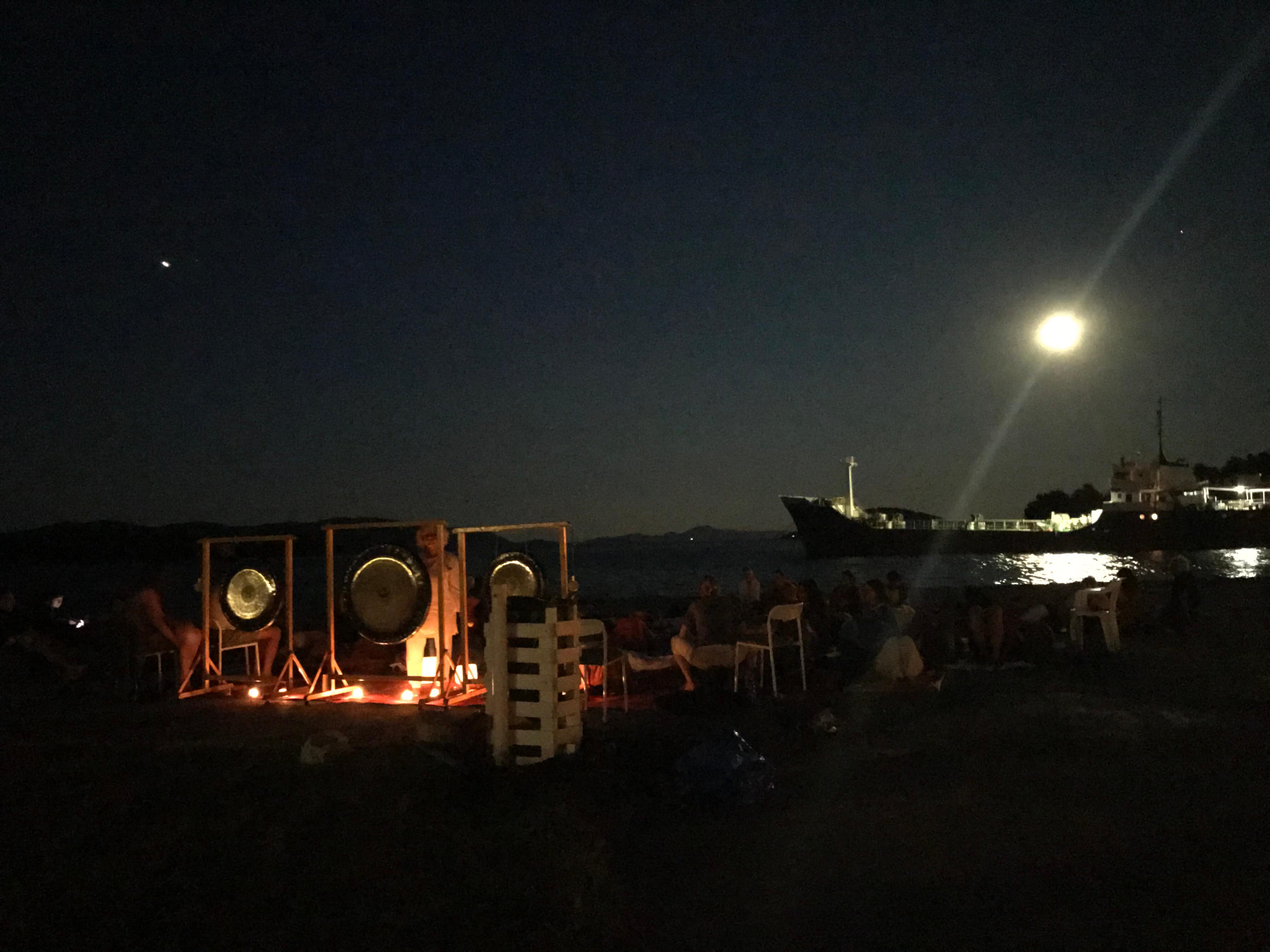
Moon gong retreat in Hotel Korinjak | Photo by: Kyla Ibero
#3 - Explore the island's rich and long history
The island of Iž has been inhabited since prehistoric times. Here, you can find traces of an Illyrian hillfort and Roma settlement. Previously named "Ez" by Emperor Constantine VII, the island was under the rule of the Zadar medieval commune but after a long feud, it was given to the Benedictine monastery of St. Mary and eventually ended up being owned by the Zadar aristocracy. Due to its long history, you can find architecture from as early as the 11th century such as the Church of St. Mary, located at the top of Mali Iž. Beside it stands a parish church which was constructed at the beginning of the 20th century. Records of the earliest Croatian settlers from the year 1266 can be found on this island, too. Iž also holds a thousand-year Glagolithic history. The parishes in both Veli and Mali Iž used to celebrate the earliest Roman Rites in the Old Church Slavonic Language, not in Latin, and based it on the liturgical books from the old Croatian Glagolitic scripts. The most recent discovery of a Glagolitic inscription was from this island at the family house of Švorinić and it was a Glagolitic inscription in stone that dates back from 1685. There are as well a lot of Glagolitic manuscripts, liturgical books, and stone epigraphs currently preserved in Iž.
#4 - Enjoy traditional pottery-making and local homemade products
The island of Iž has a long-standing culture of traditional pottery making. A special clay pot called "Iśki Lopiž" is only found on this island. This pot was traditionally used for storing olive oil and traditional kitchen condiments. It is also traditionally used for making stews on Iž because it adds a special and delicate flavour to the dish. In Veli Iž, you can find an ethnographic collection of traditional ceramics, tools, and pottery. The island is also famous for producing excellent quality olive oil, homemade vinegar, and natural soaps!
#6 - Join in the fun summer and winter events
During summer, a traditional game on Iž called "pošimpijada" is played by the locals. It is a fun competition between participants who live in the southern part of the island (team Jugo) and participants who live in the northwestern part of the island (team Zmorac). They compete in various games such as sack race, rope pulling, chess, and water basketball. Every July 29, Veli Iž celebrates Iška fešta where locals dress in traditional costumes, prepare local dishes, and perform old island dances and songs. During the festival, they also elect the King of Iž, Rava, and Lavdara. After the election, the fiesta would commence and popular singers like Oliver Dragojević, Giuliano, and Dino Dvornik would come and perform. Also during summer, a lot of concerts and theatre plays are conducted on the island. Since the winter of 2017, the island of Iž has been importing trucks of snow every winter from Lika and creates a small ski resort that has a length of 60-metres. This brings great joy to the locals during winter and few tourists who come to the island to ski.
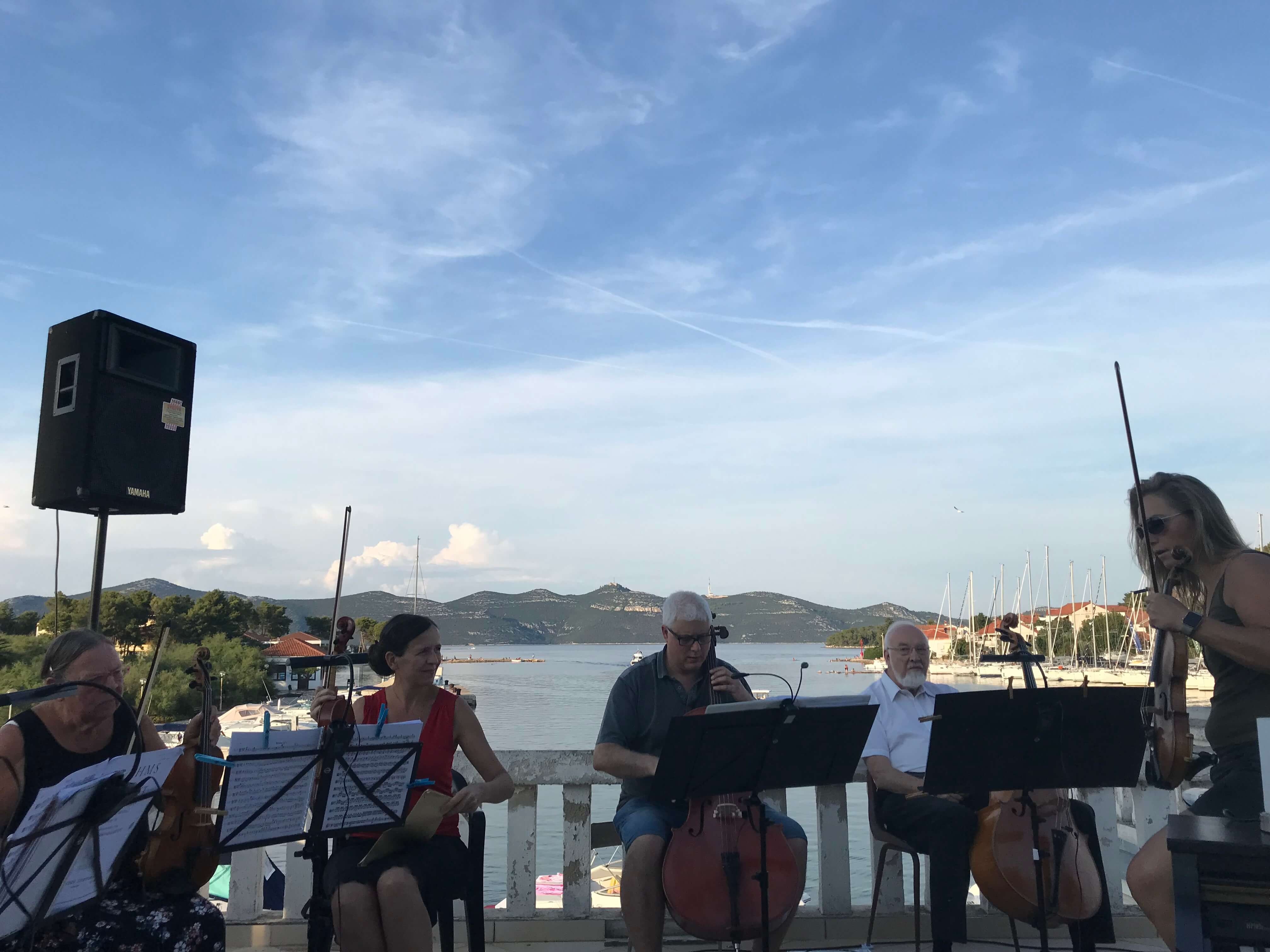
Outdoor summer concert in Iž with The Hague Chamber Orchestra | Photo by: Kyla Ibero
#7 - Authentic gastronomy
A lot of konobas and restaurants open on Iž for the summer. Since the island relies on both agriculture and fishing, the food is always offered fresh and of top quality. The cost of dining here is also relatively cheaper than other islands, for example, a plate of freshly-caught grilled seafood costs around 70HRK. The konobas and restaurants on this island all have their own special house wine. The traditional Dalmatian-cuisine which is called "brudet" is prepared on Iž with an added twist since they use their special traditional clay pot which is the "Iški Lopiž" and this heightens and elevates this dish to another level. CLICK HERE for the recipe of the traditional stew cooked in Iž using the special Iški Lopiž.
Life of a Local on Iž
My friend and a local of Iž, Tena Milinčić, shares with us the way of life in this small and secluded island because to spend a summer on Iž and to permanently live there are two completely different experiences.
Since there are only a few hundred people living on Iž, there are a few things that you cannot find on this island. First, there is no pharmacy - and the locals are kind of used to it. If they need to buy some medicine, they would have to take a ferry to Zadar or they would ask someone whom they know who is in Zadar to send it to them to Iž. There is a small ambulanta (clinic) on the island but it is not very well equipped. You cannot buy any medicine there and the doctor works only twice a week in Veli Iž and twice a week in Mali Iž.
There are also only 2 small shops on the island so the locals are accustomed to taking the ferry to Zadar to shop for their household needs and to get other services that are unavailable on the island such as printing services and hospital/clinical services.
The schools and students are slowly disappearing, too. Nowadays, on the island, there is only an elementary school up until the 8th grade. There are only around 8 students in the entire school. Not even a vrtić (kindergarten) is open because there are not enough kids on the island to attend it. This is really sad and unfortunate because there used to be a lot of educational establishments on the island especially during the war when a lot of people migrated to the island to avoid the conflict. For high school and university, locals leave the island and usually go to Zadar and other main cities in Croatia to continue their studies.
Life on this island can be sometimes idle, but in this place, you can find freedom and tranquility. The bond within the community is strong and the locals are friendly and helpful, too!
For more on lifestyle in Croatia, follow TCN's dedicated page.
For more about Croatia, CLICK HERE.
Escapes To Croatian Islands Fall, Association Hopes It Stays That Way
April 19, 2020 — Within days after Italy's country-wide coronavirus lockdown, a few of the country's boat owners sailed for Croatia's coast to avoid the infection in their own country. They arrived in marinas, on island harbors and spent a week galavanting around Zadar's archipelago while local police responded to reports of unregistered foreigners. Some even escaped via ferry to their weekend homes off the Croatian coast, before the government prohibited non-residents from going to islands.
Those days appear to be over. For now.
The early trickle of new arrivals did not become a flood, according to the head of Zadar's Civil Protection Directorate, Šime Vicković. In fact, the number of new arrivals — nautical or otherwise — has fallen close to zero, he told Zadarski List.
The problems first began with boats sailing under Italian flags arriving at Dugi Otok in the first half of March, in some cases overnighting in the Telascica Nature Park before locals reported them to police.
Tensions grew as several Italians and Slovenes took up residence in summer homes on the Dugi Otok. Neighboring islands reported a similar influx of locals during the early stages of Croatia's coronavirus response. Their compatriots did not follow them.
"All these reports are controlled by the Maritime Police, and our headquarters had a report on boaters coming to Sali, but since then we have no more reports," Vicković told Zadarski. "Those who have entered our waters are monitored by the police, warning them that they are obliged to check in if they remain here in their property and, of course, to go into self-isolation."
Croatia's islanders, or boduli, expressed dismay over the unexpected arrivals. Many were not registering with Croatia's eVisitor system, living off the radar of authorities and giving a rosier picture of the state of the islands.
Locals also worried about their population, which skews towards pensioners and those most susceptible to the virus.
The situation is, however, much different now, especially since the number of those infected is in a slight decline. The national Civil Protection Directorate's decision to prevent non-residents from traveling to islands prevented Croats, Slovenes and Italians fleeing to their vacation homes. The move may have prevented outbreaks on islands.
The president of the Croatian Islands Association, Denis Baric, appealed to the authorities to continue to protect islanders as the government mulls loosening restrictions.
"Following the situation, we must appeal to the competent authorities to do everything possible to protect our islanders, who, due to their age, are the largest crisis group," he wrote in a statement. "We are aware that every day that business owners do not work has a direct impact on their survival, and presents a direct threat to their employees. We are all anxious today for our future existence, but we are determined that we will put the life and health of every individual first."
For now, only persons residing on the islands are allowed to purchase ferry tickets to go to islands, as well as those with ePasses. The latter has become a point of contention for some, as newer faces with tenuous connections to islands show up.
Barić said the islands had a strong network to help the elderly, benefiting from the sort of small-town environment where everyone knows everyone. The Islander association said allowing non-residents to migrate to islands at this moment is akin to allowing COVID-19 to spread on Croatia's islands.
The perception of a Croatian island as an oasis against COVID-19 remains true, with the exception of Murter. Infections along the Adriatic remain relatively low, compared to larger urban centers.
"We cannot help but look back and urge the authorities to do everything possible to protect our islanders, who are the largest crisis group because of their age structure," Barić said.
Construction of Sewage System on Island of Lopud Underway
As Morski writes on the 26th of January, 2020, two underground sewage pumping stations, five kilometres of new pipelines and a submarine outfall, as well as a wastewater treatment plant will soon be constructed on the island of Lopud, just northwest of Dubrovnik.
A contract for the construction of the sewage system, worth 12 million kuna in total, was signed today between a representative of the Dubrovnik water supply company as the investor, and the Zagreb-based company Energoherc as the contractor. The signing of the contract was also attended by the Mayor of Dubrovnik, Mato Frankovic (HDZ).
Dubrovnik Mayor Mato Frankovic said he was pleased to sign the third contract for the construction of a sewage network in the area of the City of Dubrovnik, on this occasion the island of Lopud, in such a short time.
''What's a particular pleasure is the fact that we're starting with the first Elaphite island, on which one of the most important problems is the lack of a sewage network. The fact is that our tourism rests on the clean sea, and this cannot be the backbone [of Croatian tourism] if there's no sewerage network in the City of Dubrovnik.
That's why it is extremely important to solve this issue for all of the Elaphite islands, and solve the question of all of the sewage network in the city. The island of Lopud's sewer network is the first operation to start this year,'' said the Mayor before thanking the aforementioned investor for another initiated investment, and Croatian Waters (Hrvatske vode), which provided part of the funds and is following this extremely important project. He asked the residents of the island of Lopud for their patience while performing the works.
''The island of Lopud is a tourist destination, but the fact is that during the season a small part of the work can still be performed without being a burden on the season itself. Without the patience and understanding of the residents, it's difficult to get the works done on time and with quality. But I believe we can all be happy because Lopud will get a quality sewer network. They will no longer be burdened by these problems that have plagued them on a daily basis,'' said Mayor Frankovic.
On behalf of the Dubrovnik water company as investor, the contract was signed by the President of the management board, Luksa Matusic.
''This is an extremely important investment for us. Lopud is the first of the Elaphite islands to receive a sewage system. The other islands are of no less importance to us, but we've resolved all of the property-legal relations and obtained a building permit here,'' said Matusic on this occasion, emphasising that this investment is being embarked on in cooperation with Croatian Waters and will endeavor to finish it as soon as possible.
He also touched on the wastewater problems that the residents of the island of Lopud have been suffering from for the last fifteen years and pointed out that the investor has been assisting as much as it can in the last two seasons, although it doesn't have any infrastructure in its ownership.
''After Lopud, I hope that Sudjuradj will be next, in cooperation with the City of Dubrovnik, which has some of its investments planned there. Kolocep and Sipanska Luka are after Sudjuradj, for which we have a building permit. Nobody is less important to us, but here we have all the prerequisites for investing immediately after signing the contract,'' explained Matusic.
The contractor is, as mentioned previously, Energoherc, whose director Ante Simic points out that Dubrovnik, when it comes to functioning, should be an example to the rest of Croatia, which obliges them as contractors to do the job with high quality and within the given deadlines.
According to the announcement, the first machines to carry out the works on the island of Lopud can be expected as of February the 1st, 2020.
Make sure to follow our dedicated lifestyle page for more.


